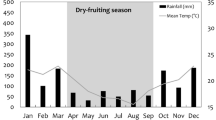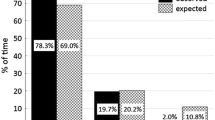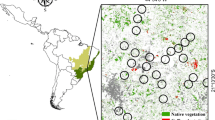Abstract
We examined the behavior of two arboreal monkeys—Piliocolobus badius (western red colobus) and Cercopithecus diana (Diana monkey)—in the presence and absence of a third, predominately terrestrial monkey, Cercocebus atys (sooty mangabey) in the Ivory Coast's Taï Forest. Via experimental data, we show that sooty mangabeys are effective sentinels for ground predators. Then we compared strata use of red colobus and Diana monkeys in the presence and absence of mangabeys. Our data indicate that red colobus and Diana monkeys descend to low forest levels and to the forest floor significantly more often when mangabeys are spatially intermingled with them, i.e. in polyspecific associations. The niche extension may provide some foraging advantage, especially for red colobus. We identified the specific causal agent—relaxed ground predator pressure—of a temporary shift in habitat use. In this instance, the presence of one species (Cercocebus atys) leads to the temporary expansion of a niche normally avoided by others Piliocolobus badius and Cercopithecus diana.
Similar content being viewed by others
REFERENCES
Alexander, R. D. (1974). The evolution of social behavior. Ann. Rev. Ecol. Syst. 5: 325–383.
Ashton, E. H., Oxnard, C. E., and Spence, T. F. (1965). Scapular shape and primate classification. Proc. Zool. Soc. Lond. 145: 125–142.
Bergmann, K. (1998). Vergleichende Untersuchung zur Einnisschung der Colobidae im Taï -Nationalpark (Procolobus verus). Master's Thesis, Johann Wolfgang Goethe-University, Frankfurt am Maim.
Bergmuller, R. (1998). Nahrungsokologie der Rauchgrauen Mangabe (Cercocebus torquatus atys), Ein Schlussel zur sozialen Organisation? Diplomarbeit Universitat Erlangen.
Boesch, C. (1994). Chimpanzees-red colobus: A predator-prey system. Anim. Behav. 47: 1135–1148.
Boinski, S., and Chapman, C. A. (1995). Predation on primates:Where are we and what's next? Ev. Anthropol. 4: 1–4.
Boinski, S., Treves, A., and Chapman, C. A. (2000). A critical evaluation of the influence of predators on primates: Effects on group travel. In Boinksi, S., and Garber, P. (eds.), On the Move: How and Why Animals Travel in Groups, University of Chicago press, Chicago, pp. 43–72.
Bshary, R., and Noë, R. (1997a). Anti-predator behavior of red colobus monkeys in the presence of chimpanzees. Behav. Ecol. Sociobiol. 41: 321–333.
Bshary, R., and Noë, R. (1997b). Red colobus and Diana monkeys provide mutual protection against predators. Anim. Behav. 54: 1461–1474.
Conover, W. J. (1980). Practical Nonparametric Statistics, JohnWiley, New York.
Cords, M. (1990). Mixed-species association of Cercopithecus monkeys in the Kakamega Forest, Kenya. University of California Publications in Zoology 117: 1–109.
Dunbar, R. (1988). Primate Social Systems, Comstock, Ithaca.
Everitt, B. S. (1997). The Analysis of Contingency Tables, London: Chapman and Hall.
Fleagle, J. (1977). Locomotor behavior and skeletal anatomy of sympatric Malaysian monkeys (Presbytis obscura and Presbytis melalophos). Yearb Phys Anthropol 20: 440–453.
Galat, G., and Galat-Luong, A. (1985). La communaute de primates diurnes de la foret de Tä?, Cote d'Ivoire. Rev. Ecol. (Terre Vie) 40: 3–32.
Garber, P. (1988). Diet, foraging patterns and resource defense in a mixed species troop of Saguinus mystax and Saguinus fuscicollis in Amazonian Peru. Behavior 105: 18–34.
Gatinot, B. L. (1976). Les milieux frequentes par le colobe bai d'Afrique de l'Oest (Colobus badius temmincki, Kuhn 1820) en Senegambie. Mammalia 40:1–12.
Gautier, J. P., and Gautier-Hion, A. (1983). Comportement vocal des males adultes et organisation supraspecifique dans les troupes polyspecifiques de Cercopitheques. Folia primatol. 40: 161–174.
Gautier-Hion, A., Gautier, J., and Quiris, R. (1981). Forest structure and fruit availability as complementary factors influencing the habitat use by a troop of monkeys (Cercopithecus cephus). Revue d'Ecologie (Terre Vie) 35: 511–536.
Gautier-Hion, A., Quiris, R., and Gautier, J. P. (1983). Monospecific vs. polyspecific life: A comparative study of foraging and anti-predatory tactics in a community of Cercopithecus monkeys. Behav. Ecol. Sociobiol. 12: 325–335.
Gebo, D., and Sargis, E. (1994). Terrestrial adaptations in the postcranial skeletons of guenons.Am. J. Phys. Anthropol. 93: 341–371.
Gebo, D., and Chapman, C. (1995). Habitat, annual, and seasonal effects on positional behavior in red colobus monkeys. Am. J. Phys. Anthropol. 96: 73–82.
Gebo, D., Chapman, C., Chapman, L., and Lambert, J. (1994). Locomotor response to predator threat in red colobus monkeys. Primates 35(2): 219–223.
Holenweg, A.-K., Noë, R., and Schabel, M. (1996). Waser's gas model applied to associations between red colobus and Diana monkeys in the Taï National Park, Ivory Coast. Folia primatol. 67: 125–136.
Honer, O. P., Leumann, L., and Noe, R. (1997). Dyadic associations of red colobus and Diana monkeys in the Taï National Park, Ivory Coast. Primates 38: 281–291.
Isbell, L. (1994). Predation on primates: Ecological patterns and evolutionary consequences.Evol. Anthro. 3(2): 61–71.
Janson, C. H. (1992). Evolutionary ecology of primate social structure. In Smith, E. A., and Winterhalder, B. (eds.), Evolutionary Ecology of Human Behavior, Aldine, New York, pp. 95–130.
Jenny, D. (1996). Spatial organization of leopards Panthera pardus in Tô? National Park, Ivory Coast: Is rainforest habitat a “tropical haven”? J. Zool. Lond. 240: 427–440.
Krebs, M. (1998). Zur Rolle von Mannchen in Familiengruppen des Olivgrunen Stummelaffen (Colobus verus)—mit Aspekten zum Sozialsystem. Master's thesis. Univ. Osnabruck.
McGraw, W. S. (1996). Cercopithecid locomotion, support use and support availability in the Taï Forest, Ivory Coast. Am. J. Phys. Anthropol. 100: 507–522.
McGraw, W. S. (1998a). Comparative locomotion and habitat use of six monkeys in the Taï Forest, Ivory Coast. Am. J. Phys. Anthropol. 105: 493–510.
McGraw and Bshary McGraw, W. S. (1998b). Locomotion, support use, maintenance activities and habitat sructure: The case of the Tô? cercopithecids. In Rosenberger, A., McHenry Fleagle, J., and Strasser, E. (eds.), Primate Locomotion: Recent Advances, Plenum Press, New York, pp. 79–94.
McGraw, W. S. (1998c). Posture and support use of OldWorld monkeys (Cercopithecidae): The influence of foraging strategies, activity patterns and the spatial distribution of preferred food items. Am. J. Primatology 46: 229–250.
Napier, J. (1963). Brachiation and brachiators. Symp. Zool. Soc. Lond. 10: 183–195.
Nöe, R., and Bshary, R. (1997). The formation of red colobus-diana monkey associations under predation pressure from chimpanzees. Proc. Roy. Soc. Lond. B. 264: 253–259.
Oates, J. F. (1988). The diet of the Olive Colobus monkey, Procolobus verus, in Sierra Leone.Int. J. Primatol. 5: 457–478.
Oates, J. F., and Whitesides, G. H. (1990). Association between Olive colobus (Procolobus verus), Diana guenons (Cercopithecus diana) and other forest monkeys in Sierra Leone.Am. J. Primatol. 21: 129–146.
Peres, C. (1993). Anti-predation benefits in a mixed-species group of Amazonian tamarins.Folia primatol. 61: 61–76.
Rice, W. R. (1989). Analyzing tables of statistical tests. Evolution 43: 223–225.
Ripley, S. (1967). The leaping of langurs: A problem in the study of locomotor adaptation. Am.J. Phys. Anthropol. 26: 149–170.
Rodman, P. (1978). Diets, densities and distributions of Bornean primates. In: Montgomery, G. G. (ed.), Ecology of Arboreal Folivores, Smithsonian Institute Press, Washington DC, pp. 465–478.
Rose, M. (1979). Positional behavior of natural populations: Some quantitative results of a field study of Colobus guereza and Cercopithecus aethiops. In Morbeck M. Preuschoft and Gomberg, N. (eds.), Environment, Behavior and Morphology: Dynamic Interactions of Primates. Gustav Fischer, New York, pp. 75–93.
Rutte, C. (1998). Die Nahrungssuchstrategie der Rauchgrauen Mangabe (Cercocebus torquatus atys). Diplomaerbeit Universitat Erlangen.
Schultz, M. (1986). The forelimb of the Colobinae. In Swindler, D. R., and Erwin, J. (eds.), Comparative Primate Biology. Vol. 1, Systematics, Evolution and Anatomy, Alan R. Liss, New York, pp. 559–669.
Shultz, S., and Nöe R. (in press). Primate predation risk varies with the distance from nests of crown eagles. Behav. Ecol. Sociobiol.
Siegal, S., and Castellan, N. J. (1988). Nonparametric Statistics for the Behavioral Sciences. 2nd edn, McGraw Hill, New York.
Stanford, C. (1995). The influence of chimpanzee predation on group size and anti-predator behavior in red colobus monkeys. Anim. Behav. 49: 577–587.
Starin, E. D. (1991). Socioecology of the red colobus monkey in The Gambia with particular reference to female-female differences and transfer patterns. PhD Thesis. City University of New York.
Starin, E. D. (1993). The Kindness of Strangers. Nat. Hist. 10: 44–49.
Struhsaker, T. (1975). The Red Colobus Monkey, University of Chicago Press, Chicago.
Struhsaker, T. (1981). Polyspecific associations among tropical rain-forest primates. Zeitschrift fur Tierpsychologie 57: 268–304.
Terborgh, J. (1983). Five New World Primates, Princeton University Press, Princeton, NJ.
Terborgh, J. (1990). Mixed flocks and polyspecific associations: Costs and benefits of mixed groups to birds and monkeys. Am. J. Primatol. 21: 87–100.
Treves, A. (1999). Has predation shaped the social systems of arboreal primates? Int. J. Primatology 20: 35–67.
Van der Hoeven, C. (1996). Hiding in the Crowd: The Anti-predation strategy of Colobus verus in comparison to two sympatric colobines; Colobus badius and Colobus polykomos.Diploma. Universiteit Utrecht.
van Schaik, C. (1983).Why are diurnal primates living in groups? Behavior 87: 120–144.
Wachter, B., Schabel, M., and Noe, R. (1997). Diet overlap and polyspecific associations of red colobus and Diana monkeys in the Tä? National Park, Ivory Coast. Ethology 103: 514–526.
Waser, P. (1984). “Chance” and mixed-species associations. Behav. Ecol. Socio. 15: 197–202.
Whitesides, G. (1989). Interspecific associations of Diana monkeys, Cercopithecus diana, in Sierra Leone,West Africa: Biological significance or chance? Anim. Behav. 37: 760–776.
Zuberbuhler, K., Noe, R., and Seyfarth, R. (1997). Diana monkey long-distance calls: Messages for conspecifics and predators. Anim. Behav. 53: 589–604.
Zuberbuhler, K., Jenny, D., and Bshary, R. (1999). The predator deterrence function of primate alarm calls. Ethology 105: 477–490.
Author information
Authors and Affiliations
Rights and permissions
About this article
Cite this article
McGraw, W.S., Bshary, R. Association of Terrestrial Mangabeys (Cercocebus atys) with Arboreal Monkeys: Experimental Evidence for the Effects of Reduced Ground Predator Pressure on Habitat Use. International Journal of Primatology 23, 311–325 (2002). https://doi.org/10.1023/A:1013883528244
Issue Date:
DOI: https://doi.org/10.1023/A:1013883528244




